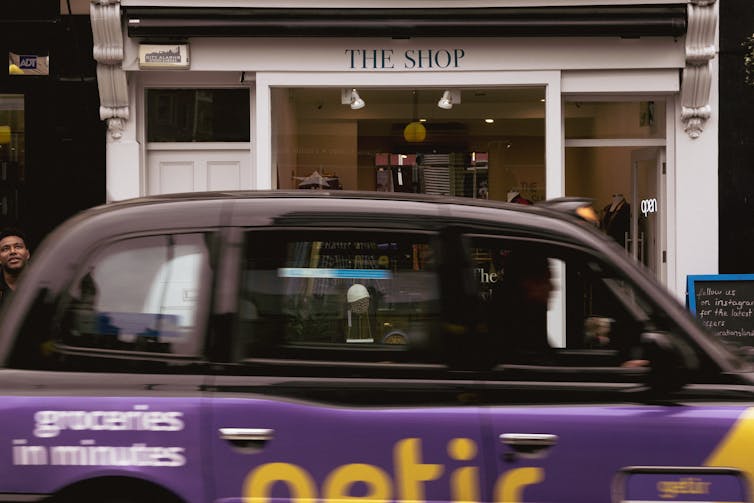Before the pandemic, online grocery shopping was typically something younger and more affluent people living in cities indulged in. When COVID hit, though, the market exploded.
In the first week of the first UK lockdown, demand for Ocado home deliveries was reportedly ten times higher than it had been the week before. But when COVID restrictions were re-imposed in September 2020, the online supermarket, like its competitors, was still warning customers that slots were selling out fast. So fast, in fact, one staffer said they were going “like Glastonbury tickets.”
Households struggled to book delivery slots, as supermarkets rightly prioritised deliveries for elderly and vulnerable consumers. And retailers hustled to capitalise on this rapid growth.
In April 2020, Tesco told its customers it had hired 12,000 extra staff and 4,000 new delivery drivers. Six months in, Sainsbury’s said it was delivering 700,000 online orders per week, having effectively doubled its capacity.

COVID lockdowns saw new demographics turn to online deliveries. Daniel Romero/Unsplash
In 2019, prior to the pandemic, my colleagues and I mapped online groceries coverage by all the major UK grocers, using the “check if we deliver to your area” tool on their websites. We found that where you live affects your choice and availability of online groceries.
People in rural areas have less access to supermarkets in general and, when it comes to online grocery shopping, just over 11% of those people have no choice at all.
Lack of choice
When households order groceries online from the major supermarkets, their orders are usually assembled in a local supermarket, what industry insiders term an “online fulfilment store”. These have dedicated staff, storage space, vehicles and drivers.
This model, however, means that online groceries are not available in all locations. Rather, they are concentrated around the network of stores that each grocer operates.

People living in rural Scotland have very few online options. Antoine Fabre/Unsplash
On each supermarket website we inputted one postcode from each of the 41,735 neighbourhoods in Great Britain – representing 25.7m households – and recorded the result. We then counted the number of retailers delivering to each neighbourhood.
We found that 98% of households in Great Britain are served by at least one of Tesco, Sainsbury’s or Asda. These three grocers offer the greatest delivery coverage, particularly in urban and suburban areas where households have a choice of grocer providing home delivery.
Other grocers have more restricted coverage. Iceland, a budget retailer with stores in urban areas, serves only 86% of households. Ocado, meanwhile, which is more upmarket and online only, delivers to only 77% of households.
Many neighbourhoods – in south-west and northern England, south and mid-Wales, and in Scotland’s borders, highlands and islands – suffer poor coverage of online groceries.
Households in many neighbourhoods in Argyll and Bute (Scotland), for example, have a single online groceries provider (Tesco). By contrast, in nearby Glasgow, most neighbourhoods have a choice of six online grocery providers.
Across Great Britain, we found that over 11% of households in the most remote rural areas have no choice of provider. They must rely on a single grocer (typically Tesco) for online groceries.
Why retailers are not expanding into rural areas
Rural areas that are underserved by supermarkets in general are precisely those that could benefit the most from better online provision. In urban contexts, the older, higher spending consumer demographic was newly converted to online grocery shopping.
In rural areas, this same demographic could therefore represent untapped demand. In other words, there is an incentive for retailers to expand there.

Supermarket coverage across Wales is much thinner than for England. Llio Angharad/Unsplash
But that is not happening. We had rare access to data about the nationwide network of Sainsbury’s stores. Over 180 of those supermarkets are in London and south-east England, 85 of which are used as online fulfilment stores. This means the retailer is able to deliver groceries to all neighbourhoods in these regions.
In Wales, by contrast, there are only four Sainsbury’s online fulfilment stores concentrated around the major towns and cities in south Wales. We found that home delivery by Sainsbury’s was unavailable to 162,000 Welsh households (12%).
Even if all existing Sainsbury’s supermarkets in Wales were used for online deliveries, over 25% of neighbourhoods would still be more than 40km from their nearest fulfilment store. Drivers could have to travel over 100km to make their deliveries. This is prohibitively expensive and inefficient.
To expand online groceries coverage beyond the store network, retailers would need to fork out considerable sums to build more stores. Most, however, have cut back on supermarket expansion plans, focusing instead on smaller convenience stores to reflect changing shopper behaviours.
Amid changing consumer behaviours, online remains a key battleground for grocers. However, it offers lower profit margins than in-store shopping due to the higher costs of order preparation and delivery.

Will Turkish online grocer Getir expand into rural areas? Metin Ozer/Unsplash
Another solution is the partnership model between grocers and online platforms such as Uber Eats, Just Eat and Deliveroo, who collect customer orders from smaller convenience stores (such as Tesco Express).
New players like the Turkish online-only grocer Getir offer rapid delivery services using smaller, more efficient warehouses located close to the customers. However, these, too, are confined to urban areas, for now.
Not being able to choose where you shop has several adverse impacts. It can restrict competition in online groceries, which in turn can see customers faced with less choice of delivery slot or higher charges for home delivery.
And, as highlighted by the consumer choice champion Which? and the Consumer Data Research Centre, it can hamper access to affordable, healthy groceries, by limiting customers’ opportunity to shop around for the best deals and widest range.
Quite how this might change though boils down to whether the major grocers or the new innovators are able to make the investments needed to better cater to rural demand. Until then, customers in these areas will face the dual disadvantage of poor access to larger supermarkets and fewer online grocery options to improve things.



 Silver Spikes to $62.89 on Fed Cut – But Weekly Bearish Divergence Flashes Caution: Don’t Chase, Wait for the Dip
Silver Spikes to $62.89 on Fed Cut – But Weekly Bearish Divergence Flashes Caution: Don’t Chase, Wait for the Dip  Robinhood Expands Sports Event Contracts With Player Performance Wagers
Robinhood Expands Sports Event Contracts With Player Performance Wagers  Fed Near Neutral Signals Caution Ahead, Shifting Focus to Fixed Income in 2026
Fed Near Neutral Signals Caution Ahead, Shifting Focus to Fixed Income in 2026 































